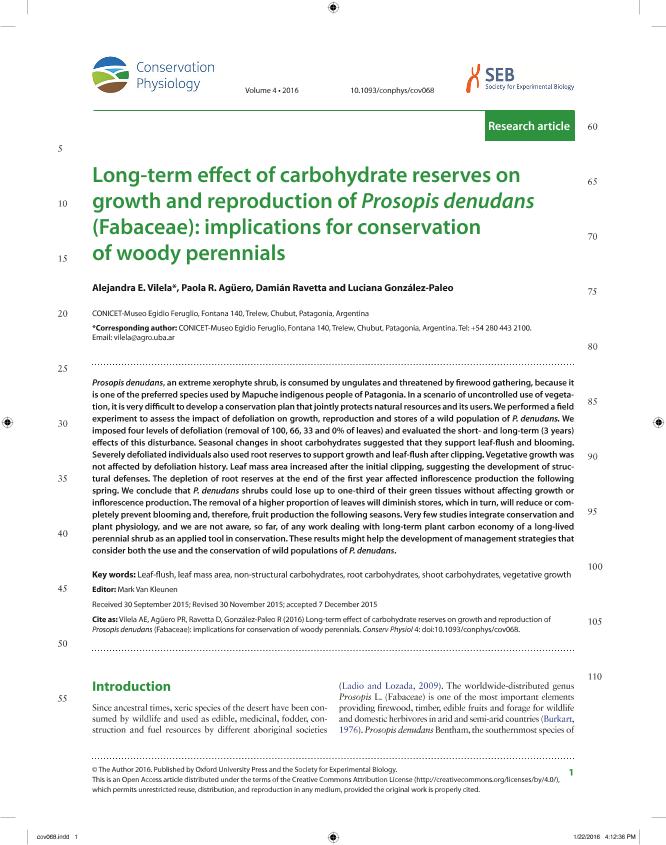Mostrar el registro sencillo del ítem
dc.contributor.author
Vilela, Alejandra Elena

dc.contributor.author
Agüero, Paola R.
dc.contributor.author
Ravetta, Damián Andrés

dc.contributor.author
González Paleo, Luciana

dc.date.available
2020-09-15T14:37:18Z
dc.date.issued
2016-01
dc.identifier.citation
Vilela, Alejandra Elena; Agüero, Paola R.; Ravetta, Damián Andrés; González Paleo, Luciana; Long-term effect of carbohydrate reserves on growth and reproduction of Prosopis denudans (Fabaceae): implications for conservation of woody perennials; Oxford University Press; Conservation Physiology; 4; 1; 1-2016; 1-9
dc.identifier.issn
2051-1434
dc.identifier.uri
http://hdl.handle.net/11336/113989
dc.description.abstract
Prosopis denudans, an extreme xerophyte shrub, is consumed by ungulates and threatened by firewood gathering, because itis one of the preferred species used by Mapuche indigenous people of Patagonia. In a scenario of uncontrolled use of vegetation,it is very difficult to develop a conservation plan that jointly protects natural resources and its users. We performed a fieldexperiment to assess the impact of defoliation on growth, reproduction and stores of a wild population of P. denudans. Weimposed four levels of defoliation (removal of 100, 66, 33 and 0% of leaves) and evaluated the short- and long-term (3 years)effects of this disturbance. Seasonal changes in shoot carbohydrates suggested that they support leaf-flush and blooming.Severely defoliated individuals also used root reserves to support growth and leaf-flush after clipping. Vegetative growth wasnot affected by defoliation history. Leaf mass area increased after the initial clipping, suggesting the development of structuraldefenses. The depletion of root reserves at the end of the first year affected inflorescence production the followingspring. We conclude that P. denudans shrubs could lose up to one-third of their green tissues without affecting growth orinflorescence production. The removal of a higher proportion of leaves will diminish stores, which in turn, will reduce or completelyprevent blooming and, therefore, fruit production the following seasons. Very few studies integrate conservation andplant physiology, and we are not aware, so far, of any work dealing with long-term plant carbon economy of a long-livedperennial shrub as an applied tool in conservation. These results might help the development of management strategies thatconsider both the use and the conservation of wild populations of P. denudans.
dc.format
application/pdf
dc.language.iso
eng
dc.publisher
Oxford University Press

dc.rights
info:eu-repo/semantics/openAccess
dc.rights.uri
https://creativecommons.org/licenses/by/2.5/ar/
dc.subject
LEAF MASS AREA
dc.subject
LEAF-FLUSH
dc.subject
NON-STRUCTURAL CARBOHYDRATES
dc.subject
ROOT CARBOHYDRATES
dc.subject
SHOOT CARBOHYDRATES
dc.subject
VEGETATIVE GROWTH
dc.subject.classification
Ciencias de las Plantas, Botánica

dc.subject.classification
Ciencias Biológicas

dc.subject.classification
CIENCIAS NATURALES Y EXACTAS

dc.title
Long-term effect of carbohydrate reserves on growth and reproduction of Prosopis denudans (Fabaceae): implications for conservation of woody perennials
dc.type
info:eu-repo/semantics/article
dc.type
info:ar-repo/semantics/artículo
dc.type
info:eu-repo/semantics/publishedVersion
dc.date.updated
2020-09-11T18:49:46Z
dc.journal.volume
4
dc.journal.number
1
dc.journal.pagination
1-9
dc.journal.pais
Reino Unido

dc.description.fil
Fil: Vilela, Alejandra Elena. Museo Paleontológico Egidio Feruglio; Argentina. Consejo Nacional de Investigaciones Científicas y Técnicas; Argentina
dc.description.fil
Fil: Agüero, Paola R.. Museo Paleontológico Egidio Feruglio; Argentina
dc.description.fil
Fil: Ravetta, Damián Andrés. Consejo Nacional de Investigaciones Científicas y Técnicas; Argentina. Museo Paleontológico Egidio Feruglio; Argentina
dc.description.fil
Fil: González Paleo, Luciana. Museo Paleontológico Egidio Feruglio; Argentina. Consejo Nacional de Investigaciones Científicas y Técnicas; Argentina
dc.journal.title
Conservation Physiology
dc.relation.alternativeid
info:eu-repo/semantics/altIdentifier/url/https://academic.oup.com/conphys/article/4/1/cov068/2951309
dc.relation.alternativeid
info:eu-repo/semantics/altIdentifier/doi/http://dx.doi.org/10.1093/conphys/cov068
Archivos asociados
